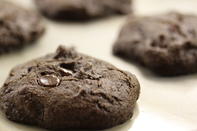Carob trees (Ceratonia siliqua) produce leathery seed pods that turn brown as they ripen. The pods have a sweet-tasting pulp and small seeds. Carob seeds are high in natural sugars, proteins, vitamin A, B vitamins, minerals such as calcium, silica, iron and phosphorous and contains less than 1% fat.

After harvesting the brown pods, they are broken open and the seeds removed. The empty pods are then washed, roasted (which inactivates enzymes) and then milled. The fine brown powder is used as cocoa but without needing sugar.
But unlike cocoa, carob does not contain caffeine, theobromine (a stimulant that can cause headaches) or oxalic acid. In food processing carob flour, mixed with skim milk powder, a vegetable oil and soy lecithin produces a solid carob ingredient that can be used in many food products.
Permaculture News recommends the following process to make carob seed powder at home. Wash the ripe (brown) pods and boil in just enough water to cover until tender.
Cooking softens the pods and makes it easier to open and remove the seeds. Chop the pods in small pieces and dry well before grinding it to a powder.
Carob Seed Gum
Carob seeds contain up to 35% gum, which is used in the manufacture of adhesives, cosmetics, pharmaceuticals, detergents, paint, ink, shoe polish, in the textile industry, in photographic paper, insecticides and match heads.
It is also used in the tanning of leather. In the manufacturing of rubber latex, locust bean gum is added to cause the solids to float to the surface. It is also used for bonding paper pulp and thickening silkscreen pastes.
Carob seed gum (also called locust bean gum) is widely used in food industries as a thickener and stabiliser of emulsions in foods such as baked products, ice cream, salad dressings, sauces, salami, canned meats and fish, jelly and mustard.
The pods can be chewed as a sweet, but industrially it is processed to a cocoa-like flour which can be added to cold or hot milk for drinking, combined with wheat flour for bread or pancakes and has been utilized in breakfast foods.
The finer flour is used in candy bars and the ground-up pods are boiled in water to produce a thick syrup. After gum extraction from the carob pulp, the seed residue can be made into a high protein (60%), starch- and sugar-free flour suitable for diabetics.
Other Uses of Carob
In Germany and Spain, the roasted carob seeds, which are caffeine-free, are a coffee substitute or mixed in with coffee. Infusions of the carob pulp can be fermented to produce alcoholic beverages. In South Africa, carob trees are widely planted to line streets, paths and parking areas, because they are evergreen, hardy and require little water.
The dense foliage of the carob tree also acts as a noise breaker and it is often planted as a windbreak next to orchards. Research by Lucas Iipumbu has concluded that carob has the possibility of becoming a high-value cash crop in South Africa due to the industrial demands for carob seed gum.
By Marinda Louw